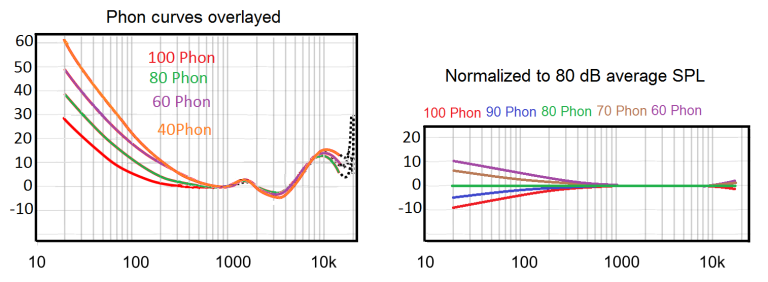- Thread Starter
- #281
Thanks, a few useful points for my HD600 there, I'll also take a look at your site there that you linked....previously I've seen your HD600 page and I found the distortion graph notable below 100Hz and your listening experience I value because I think it mirrored mine with the NAD HP50 & AKG K702 for example. Someone told me you do hardware EQ for specific headphones too, so I might take a look at what specific changes you made to the HD600. Thanks for your posts here, I can see you've put time & thought into them.All it needs is the proper correction for the lows and you could pull down the region between 3k and 5k with about 1dB or so.
Griesinger uses the equal loudness trick as an intermediate step to determine his HRTF. That's why the FR of the speakers is more or less irrelevant.
When you do this at a louder level the equal loudness contour effect of our hearing is less relevant.
Equal loudness contour correction HAS to be variable and must be calibrated at actual SPL. This is dependent on voltage efficiency of the headphone, gain of the used amplifier and setting.
The old 'contour' switch on the volume control of older amps did just that. Only worked correctly with the certain speakers. This was integrated in the volume control (it had one or 2 'taps').
The RME also has something similar but digital.
When listening at very low levels it could be a pleasant experience as the bass goes up at lower levels.
You cannot EVER do a fixed 'loudness contour' correction for any headphone. period.
That said, my 'bass' correction in my plots are derived from the difference one mixes to in studios and actual headphone listening.
This usually is done at lower levels (for those with some common sense, so excluding some younger folks that play alarmingly loud)
So this differs from the (steep) bass correction of Harman as that is determined by preferences of many people. Most like some increased bass.
My 'correction' is based on equal loudness contours and my listening habits.
My reasoning is explained here.

I know it differs from 'the missing 6dB effect', reasoning for bass boost in room and O-W preference research. I based my theory on equal loudness contours effects which to me makes sense because of my listening habits.
So yes, in the end my bass correction actually is based on equal loudness contours and thus my 'EQ' on this also with similar-ish 'effects' as Golden Ears, O-W and other 'bass' corrections. Correction for lows is essential. My method is just less extreme (in amplitude abd steepness) and to, to me, more logical 'natural' change instead of an unnatural sudden one (GE and O.W.) and far less 'extreme' as Sonarworks.
You don't have to agree though.
The effect comes very close to the tonal balance I get from 'flat' near-field speakers in a large room at 1m distance when switching to headphones that measure 'flat' on MY testrig at levels I can easily sustain for a few hours. That is my goal. Not the ones of other people necessarily.
EDIT: after looking at your HD600 page I think you would be suggesting about a 5dB Low Shelf from 50Hz, assuming I was only bothered with extension to 20Hz rather than 10Hz. (which happens to be the same Low Shelf I use on my K702's).
Last edited:
